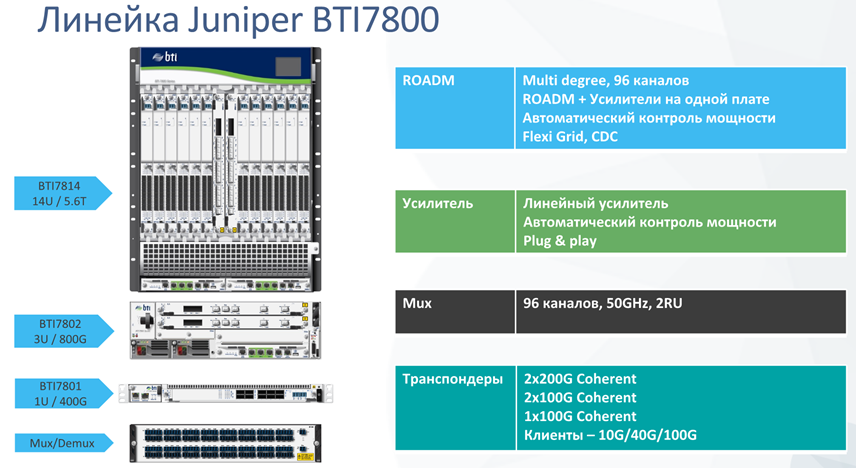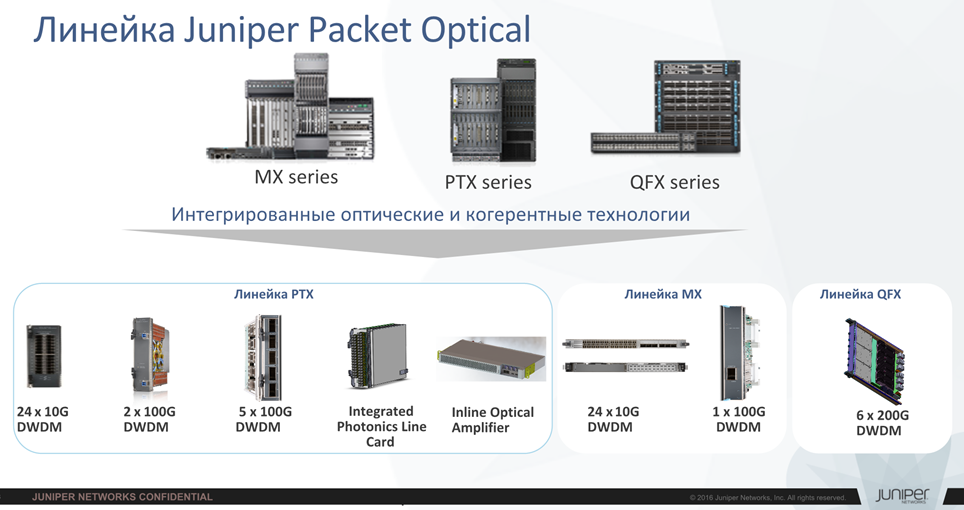Juniper offers BTI hardware
The combination of the development of these two companies promises to provide maximum value solutions for users and end-to-end product portfolio of world-class. Typical customers of such solutions are companies in fast-growing markets that need to interact with data centers and optical data transmission systems.

Although the popularity of cloud solutions is growing rapidly, the cloud is not going to kill data centers at local sites of enterprises, at least for now.
“Data explosion” - a sharp increase in their volume in the last decade - has stimulated the growth of both private data centers and public clouds. Today, almost all IT leaders of companies are considering, planning and implementing a transition to a hybrid cloud, which combines the advantages of both options.
')
It is wrong to say that cloud computing is just a new computing model. It differs from other computational paradigms in that it is very network oriented and depends on them. In other words, companies will not achieve the desired results in the cloud without building an appropriate network infrastructure.
In January 2017, Juniper expanded its Unite structure to help customers build their data center network fully ready for use in the cloud.
Unite was introduced by Juniper in 2015 as a framework for campus network level (camp for campus network). Later, the structure for the cloud division was announced (cloud-enabled branch). The described solution of the data center level is the newest, third stage and the most powerful solution for building the Unite structure. Its main characteristics are as follows.
Safety Like many developers, Juniper wants to implement a single and unique security policy for its solutions. The company moves to a model where for each element of the “cloud stack” a corresponding security policy is provided.
Automation . Juniper solutions are automated by its Junos open source API, which interacts with various programming languages and orchestration tools, such as Chef, Puppet, Python, and others. In addition, Juniper has developed an API in its Network and Security Directors software that provides interoperability with OpenStack, Kubernetes, VMware, and others.
Analytics and machine learning . Needless to say, the availability of data is essential. But the ability to correctly interpret them gives the data much greater practical value. Juniper now has the ability, for example, to collect telemetry information and then analyze it, thanks to the machine learning engine (machine learning), which was obtained by purchasing AppFormix.
Intent-based networking . This is what Juniper often talks about lately. Previously, the network was formed at the switch level. Juniper implemented an “intent-based system”. In it, the administrator can give, for example, the command “Create red and blue virtual networks”. The network is able to interpret such a command and place all endpoints marked in blue on one network, and red on another.
About a year ago (January 2016) Juniper announced the acquisition of BTI Systems, a company that specialized in SDN (Software-Defined Networking) solutions and developed the appropriate hardware for them.
BTI was founded in 2000. Its headquarters is located in Ottawa (Canada). At the time of purchase, the company had about 380 customers. The company specializes in building both cloud and traditional networks. This allows you to move content to / from many data centers in a local geographic area, such as a city.
“We expect that this acquisition will allow Juniper to speed up the delivery of packet optical data transfer solutions (packet optical transport solutions), which will be combined with our NorthStar Controller, which includes network management tools that will provide full control of new services,” the executive wrote on his blog. Juniper vice president and CEO, Jonathan Davidson.
The BTI7800 Series Packet Optical Transport Platforms is an open, programmable, scalable and flexible network system. It is designed for service and cloud providers, meeting their needs for high-bandwidth network solutions.

BTI7800 Packet Optical Transport Platforms
The system reduces the unit cost of the transmitted gigabit, increases the utilization rate of the network, simplifies network operations and provides great opportunities in a compact physical form factor.
A rich set of optical capabilities is provided with 200 Gbps modules with an integrated ROADM (Reconfigurable Optical Add-Drop Multiplexer) multiplexer.

Packet optical solutions
Due to these features, the client can increase network bandwidth, reduce the cost of space occupied by hardware, power and cooling, improve network utilization and simplify service deployment.
The platform has a modular and flexible architecture, providing the pay-as-you-grow principle. It supports a wide range of interfaces, including 10, 100, and 200 Gbps, OTU2, OTU4 and OC-192 / STM-64.
The system automatically detects and connects all network nodes and modules in the IT infrastructure of the enterprise, simplifying operations and eliminating the configuration manually, which is especially important when performing error-prone tasks in conditions of intensive work.
The system is typically managed by Juniper Networks proNX Service Manager, a highly efficient SDN class network solution with an open API and a web interface.
In the past few years, Juniper has had some ups and downs. However, in the end, she always successfully solved tough network problems and provided assistance to her clients in solving such problems.
The Unite framework (Unite framework) seems to be a good solution, which can now be recommended to Juniper Networks customers.

Juniper Cloud Solutions
Although the popularity of cloud solutions is growing rapidly, the cloud is not going to kill data centers at local sites of enterprises, at least for now.
“Data explosion” - a sharp increase in their volume in the last decade - has stimulated the growth of both private data centers and public clouds. Today, almost all IT leaders of companies are considering, planning and implementing a transition to a hybrid cloud, which combines the advantages of both options.
')
It is wrong to say that cloud computing is just a new computing model. It differs from other computational paradigms in that it is very network oriented and depends on them. In other words, companies will not achieve the desired results in the cloud without building an appropriate network infrastructure.
In January 2017, Juniper expanded its Unite structure to help customers build their data center network fully ready for use in the cloud.
Unite was introduced by Juniper in 2015 as a framework for campus network level (camp for campus network). Later, the structure for the cloud division was announced (cloud-enabled branch). The described solution of the data center level is the newest, third stage and the most powerful solution for building the Unite structure. Its main characteristics are as follows.
Juniper Networks Unite
Safety Like many developers, Juniper wants to implement a single and unique security policy for its solutions. The company moves to a model where for each element of the “cloud stack” a corresponding security policy is provided.
Automation . Juniper solutions are automated by its Junos open source API, which interacts with various programming languages and orchestration tools, such as Chef, Puppet, Python, and others. In addition, Juniper has developed an API in its Network and Security Directors software that provides interoperability with OpenStack, Kubernetes, VMware, and others.
Analytics and machine learning . Needless to say, the availability of data is essential. But the ability to correctly interpret them gives the data much greater practical value. Juniper now has the ability, for example, to collect telemetry information and then analyze it, thanks to the machine learning engine (machine learning), which was obtained by purchasing AppFormix.
Intent-based networking . This is what Juniper often talks about lately. Previously, the network was formed at the switch level. Juniper implemented an “intent-based system”. In it, the administrator can give, for example, the command “Create red and blue virtual networks”. The network is able to interpret such a command and place all endpoints marked in blue on one network, and red on another.
Juniper and BTI Systems
About a year ago (January 2016) Juniper announced the acquisition of BTI Systems, a company that specialized in SDN (Software-Defined Networking) solutions and developed the appropriate hardware for them.
BTI was founded in 2000. Its headquarters is located in Ottawa (Canada). At the time of purchase, the company had about 380 customers. The company specializes in building both cloud and traditional networks. This allows you to move content to / from many data centers in a local geographic area, such as a city.
“We expect that this acquisition will allow Juniper to speed up the delivery of packet optical data transfer solutions (packet optical transport solutions), which will be combined with our NorthStar Controller, which includes network management tools that will provide full control of new services,” the executive wrote on his blog. Juniper vice president and CEO, Jonathan Davidson.
Ruler BTI7800
The BTI7800 Series Packet Optical Transport Platforms is an open, programmable, scalable and flexible network system. It is designed for service and cloud providers, meeting their needs for high-bandwidth network solutions.

BTI7800 Packet Optical Transport Platforms
The system reduces the unit cost of the transmitted gigabit, increases the utilization rate of the network, simplifies network operations and provides great opportunities in a compact physical form factor.
A rich set of optical capabilities is provided with 200 Gbps modules with an integrated ROADM (Reconfigurable Optical Add-Drop Multiplexer) multiplexer.

Packet optical solutions
Due to these features, the client can increase network bandwidth, reduce the cost of space occupied by hardware, power and cooling, improve network utilization and simplify service deployment.
The platform has a modular and flexible architecture, providing the pay-as-you-grow principle. It supports a wide range of interfaces, including 10, 100, and 200 Gbps, OTU2, OTU4 and OC-192 / STM-64.
The system automatically detects and connects all network nodes and modules in the IT infrastructure of the enterprise, simplifying operations and eliminating the configuration manually, which is especially important when performing error-prone tasks in conditions of intensive work.
The system is typically managed by Juniper Networks proNX Service Manager, a highly efficient SDN class network solution with an open API and a web interface.
Conclusion
In the past few years, Juniper has had some ups and downs. However, in the end, she always successfully solved tough network problems and provided assistance to her clients in solving such problems.
The Unite framework (Unite framework) seems to be a good solution, which can now be recommended to Juniper Networks customers.
Source: https://habr.com/ru/post/321908/
All Articles